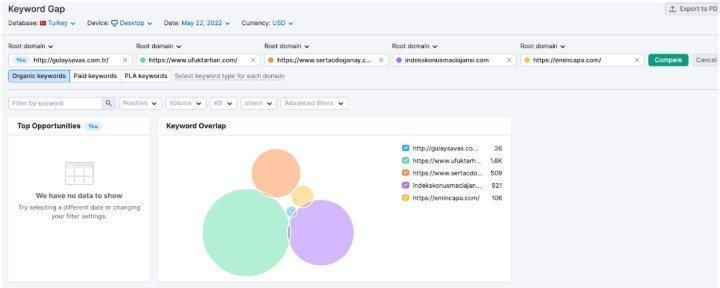
Each website receives variable traffic from keywords according to its unique keyword pool. Our competitors in the same industry also get traffic from certain keywords just like us. So, if we want to analyze our competitor’s keywords and attract the user to our own website due to the traffic they get, how can we achieve this?
In this article, I will be telling you about Keywords Gap, which is an indispensable part of competitor and industry market share research in SEO. Keywords Gap, with its simple definition, is to collect the keywords from which our competitors get traffic and the keywords from which our site receives traffic in a pool and analyze it using various filters.
Keywords Why is Gap Competitor Analysis Necessary?

Every business/company has a bigger competitor, market leader, but potential threats. As in every commercial market, businesses make many moves against their competitors to get the most profit at the end of the month. These moves can be directly effective methods such as attracting the traffic of their competitors to their own website.
SEO consultants can learn vital information for a business-company, such as knowing your competitors, learning and analyzing your shortcomings, determining your strengths and weaknesses, thanks to Keywords Gap. Correctly designed Keywords Gap studies will allow you to know your competitors and create permanent brand strategies.
Keywords How to Build a Gap?

Keywords Many paid and free tools are available for creating a gap. Among the existing tools, there are 2 popular tools that analyze such high data and give the closest results to the correct results. These tools are Semrush and Ahrefs. Both are popular paid SEO tools that are well known to people who have done SEO work or received SEO services before.
In this article, we will use Semrush while describing the Keywords Gap setup. This setup, which is almost the same in Ahrefs, varies from vehicle to vehicle in terms of visuality and functionality, but the structure is always the same. Analyze your competitors’ and your own keywords and perform competitor analysis.
How to Create Semrush Keywords Gap?
When Keywords Gap option is clicked on Semrush’s vertical menu on the left, you will see the area where Keywords Gap editing will be performed. You must add

Root Domain website addresses. You should add your own website address in the first field. While Semrush analyzes keywords and your competitors, it provides filtration according to the website here. For this reason, you should definitely enter your own website address in this field.
Next, you should add the addresses of your competitors’ websites. If you don’t have enough competitor information, you don’t have to worry. Thanks to its smart algorithms, Semrush runs an algorithm in the background as soon as you add your website address and starts to analyze the competitors that are suitable for you. When you come to the adding website address part, Semrush will show you at least 3 competitors in each column, based on the keywords you get traffic for. Although Semrush’s suggested competitors are 80% likely to be your real competitors, it is always useful to manually open websites and take a quick look.
After adding our competitors, we press the compare button and Semrush starts analyzing our competitors for us. The analysis process is completed in an average of 2-3 times.
After the transaction is completed, we are presented with a graph of the market share. A bubble chart appears before us. We can visually understand which competitor and keywords we use in common in the chart. In addition, thanks to this chart, we can easily learn the market leader.

When we scroll down the page, we see the keywords listed. Here, 7 ready-made filters are waiting for us. Just using these filters means that you finish most of the competitor analysis section.
Semrush Keywords Gap Competitor Analysis
The meanings of the Ready Keywords Gap filters are as follows, respectively,
- Shared: Every entered competitor and our website are key here. sorted in words.
- Missing(Missing) Every competitor entered has rank in the keywords here, but we did not rank. It is very important data for competitor analysis and market share.
- Weak Our keywords that rank lower than competitors’ keywords. It is very important that we strengthen the keywords here.
- Strong(Strong) Our keywords that we are strong against our competitors.
- Untapped Keywords that are used by at least one of the competitors and rank in Google but we did not. There can be quite a lot of keywords here according to the market share, but there is no need to get demoralized. You can prioritize and rank your keywords with the filtration processes that I will show you shortly.
- Unique Keywords that you rank for but your competitors do not.
- All(Everything) This is the field where all keywords are listed without filtering.
Keywords Gap Filtering Operations
Although Semrush Keywords offers ready-value filters in Gap editing, re-filtering thousands of keyword lists is the best way for goal-oriented studies. That’s why I’m going to show you 2 simple but effective filtering operations.

Include searches the entered keyword among the listed keywords and shows that they found a match in the keyword phrase. For example, if I apply the Include filter to the SEO keyword, it will only show me the keywords that contain SEO. It will not show anything else. It is one-to-one in goal-oriented work.
Exclude As the name suggests, it works as the opposite of Include. If I apply the Exclude filter to the keyword I entered here, it will remove all the results where the entered keyword is mentioned. For example, if I apply the Exclude filter to the SEO keyword, I will see keywords that do not include SEO.
- Home
- Internet
- Website News
- Keywords What is Gap?